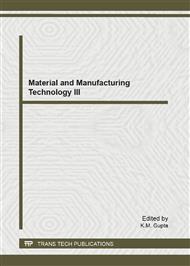p.415
p.421
p.425
p.429
p.433
p.438
p.444
p.450
p.456
Investigation of Material Properties and Force of 6-Year-Old Children Lumbar FEM
Abstract:
The purpose of this study was to investigate injury mechanism and injury biomechanical response of children lumbar segment L4-L5. Firstly, the geometric model of lumbar segment at L4-L5 was extracted from CT scan images of a healthy 6-year-old child for from repairing and refining by reverse engineering software Geomagic to finite element (FE) pre-processing by Hypermesh. The FE model was calculated by LS-Dyna under the conditions given by cadaveric experiments, in which a static load was applied to the center of lumber segment at L4-L5 by a metal plate. The static load was subsequently moved forward and backward 10mm in sagittal plane, respectively. The interfacial force between articular surfaces was the objective to investigate for the comparison between the simulation and the cadaveric experiment as well as the simulation by adult FE model. The simulated results showed that the displacement between L4 and L5 of children was, to some extent, smaller than that of adults. The ratio of calculated force between articular surfaces of L4-L5 of children to the applied force moreover was, to a great extent, smaller than that of adults. Children are much easier to be rendered injury at L4-L5 than adults are, because articular surfaces of children relatively more slightly contribute to distributing the force that nucleus pulposus undergoes than those of adults do. Hence, the current study could be perceived as a theoretical basis for the product design toward vehicle safety.
Info:
Periodical:
Pages:
433-437
Citation:
Online since:
July 2012
Authors:
Keywords:
Price:
Сopyright:
© 2012 Trans Tech Publications Ltd. All Rights Reserved
Share:
Citation:


